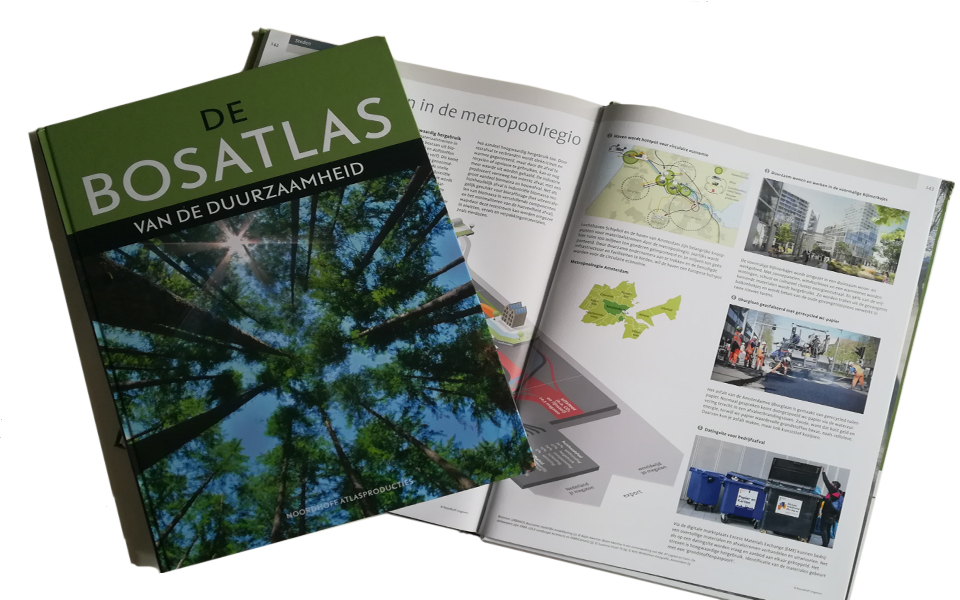[:nl]De nieuwe Bosatlas van de Duurzaamheid is uitgekomen.De atlas laat zien wat de invloed is van de mens op de aarde, zoals klimaatverandering, het opraken van de grondstoffen en het verlies aan biodiversiteit. De Bosatlas van de Duurzaamheid geeft ook inzicht in de (inter)nationale afspraken die gemaakt zijn om de menselijke invloed te minderen. Natuurlijk heeft iedereen hier een rol in, dus de Bostatlas geeft tips en adviezen aan bedrijven, burgers en overheden hoe zij hun impact kunnen verkleinen. Alles is geweldig geïllustreerd met duidelijke en overtuigende kaarten en grafieken.
De Bosatlas van de Duurzaamheid beschrijft o.a. hoe de materiaalstromen in de metropoolregio van Amsterdam lopen. In ons project over de circulaire haven van Amsterdam laten wij zien welke rol de haven kan hebben in de materiaalstromen door de regio. In de Bosatlas van de Duurzaamheid is een illustratie van de circulaire haven opgenomen. Leuk om op deze manier te hebben bijgedragen aan de Bosatlas.
De circulaire economie is een kans voor de haven, maar heeft ook consequenties voor bijvoorbeeld andere bedrijventerreinen, woonwijken en winkelcentra. In verschillende projecten laten wij zien wat de kansen zijn voor een gebied als de circulaire economie principes worden toegepast. Hierbij is het meenemen van de stakeholders van belang en dat proberen wij op verschillende actieve manieren te bereiken door de circulaire economie heel concreet en tastbaar te maken.
[:en]The new Atlas of Sustainability has been released, showing the impact of humans on the earth, such as climate change, the depletion of raw materials and the loss of biodiversity. The Atlas also provides insight into the (inter) national agreements that have been made to reduce the human impact on the planet. Of course, everyone has a role in this, so the Atlas provides tips and advice to companies, citizens and governments on how to reduce their impact. Everything is beautifully illustrated with clear and compelling maps and charts.
Among other things, the Atlas describes how the material flows in the Amsterdam metropolitan area go. In our project on the circular port of Amsterdam, we show what role the port can have in the material flows through the region. The Atlas of Sustainability includes an illustration of the circular port made by URBANOS. Nice to have contributed in this way to the Bosatlas.
The circular economy is an opportunity for the port, but it also has consequences for other business parks, residential areas and shopping centers, for example. In various projects we show what the opportunities are for an area if the circular economy principles are applied. It is important to include stakeholders and we try to achieve this in various active ways by making the circular economy very concrete and tangible.[:es]Se lanzó el nuevo Atlas de la Sostenibilidad, que muestra el impacto de los humanos en la tierra, como el cambio climático, el agotamiento de las materias primas y la pérdida de biodiversidad. El Atlas también proporciona información sobre los acuerdos (inter) nacionales que se han hecho para reducir el impacto humano en el planeta. Por supuesto, hay un rol para todo el mundo en esto y por eso el Atlas incluye consejos y sugerencias a empresas, ciudadanos y gobiernos sobre cómo reducir su impacto. Todo está bellamente ilustrado con mapas y gráficos claros y convincentes.
Entre otras cosas, el atlas describe los flujos de materiales en el área metropolitana de Amsterdam. En nuestro proyecto en el puerto circular de Amsterdam, mostramos qué papel puede tener el puerto en los flujos de material a través de la región. El Atlas incluye una ilustración de URBANOS del puerto circular. Es un honor haber contribuido de esta manera a un Atlas tan relevante.
La economía circular es una oportunidad para el puerto, pero también tiene consecuencias para otros parques empresariales, zonas residenciales y centros comerciales, por ejemplo. En varios proyectos mostramos cuáles son las oportunidades para un área si se aplican los principios de la economía circular. Es importante incluir a las partes interesadas y tratamos de lograrlo de varias maneras activas haciendo que la economía circular sea muy concreta y tangible.[:]



![[:nl]Lancering boek Batallon San Mateo[:]](https://www.urbanos.nl/wp-content/uploads/San-Mateo-Libro-500x383.jpg)
![[:nl]Plein voor buurt[:en]Neighbourhood square[:]](https://www.urbanos.nl/wp-content/uploads/URBANOS-Galjoen-perspectief-500x383.jpg)
![[:nl]Future City op het European Forum Alpbach[:en]Future City at European Forum Alpbach[:]](https://www.urbanos.nl/wp-content/uploads/Forum-Alpbach-500x383.png)
![[:nl]Genereus Stadmaken![:en]Generous city![:]](https://www.urbanos.nl/wp-content/uploads/SLOWFestival-Genereus-Groningen-pink-500x383.jpg)
![[:nl]Inclusief vastgoed[:]](https://www.urbanos.nl/wp-content/uploads/ASRE-500x383.png)